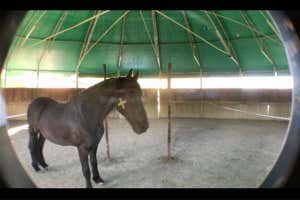A study confirms this: Horses not only recognize themselves in the mirror, but can even use the information in their reflection to recognize stains or marks for cleaning.
Eleven horses out of a group of 14 tested tried to rub the colored markings off their cheeks after discovering them in the mirror.
This would make them the only animals, other than primates, capable of self-recognition in the mirror, he says Paul Baragli of the University of Pisa.

Self-recognition has previously been detected in some other species (elephants, bottlenose dolphins, magpies) but on very small groups, which did not allow us to confirm whether the species as a whole have this ability.
For horses this seems to be a general feature.
I'm starting with the Horse in the Mirror, Michael Jackson would say
Baragli and his colleagues placed a large mirror upright in an indoor arena and released 14 horses, one at a time, into the open space. Initially, everyone treated their reflection as if it were another horse. Some tried to play with the “other horse,” and some were afraid or even aggressive towards him, Baragli says.
After this initial reaction period, which varied from individual to individual, most of the horses changed their behavior and began to investigate. A bit as if they wanted to "test" to see if the horse in the mirror was actually a reflection of themselves, says Baragli.
Eleven of the horses checked behind the mirror and tested their reflexes by moving their heads. Some even showed the language.
Second phase of the horse test
The researchers then used a medical ultrasound gel to mark the cheeks of the 11 horses. The horses could not see him except in the mirror. A visible sign, a beautiful “X”.
The horses recognized from their reflection that they had something on their faces and wanted to understand more, or remove it.
Doubts about the results
The developer of the tests Gordon Gallup of the University of Albany in New York, considers Baragli's conclusions "dubious". He particularly disagrees that the horses were actually investigating their mirror images. This type of “self-directed” behavior is an important factor in research.
Baragli stands by his conclusions based on 22 hours of video, which include multiple instances of horses looking at themselves, rubbing their faces and looking again in the mirror. “They're trying to explore the mark on their face or remove it,” he says. “It is difficult to imagine that there is another reason for this behavior.”
I don't know if this proves that horses are self-aware. That they see themselves as individuals, that they are aware of their uniqueness.
But self-recognition in one mirror it is certainly an important "building block" of self-awareness.
Journal reference: Animal cognition , DOI: 10.1007/s10071-021-01502-7


